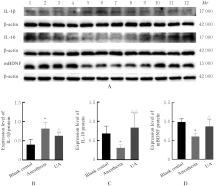| [1] |
Yu ZHANG,Xianling LU.
Expressions of IL-33, IL-8, and NETs in lung tissue of patients with chronic obstructive pulmonary disease and their significances
[J]. Journal of Jilin University(Medicine Edition), 2024, 50(2): 498-507.
|
| [2] |
Wei CHEN,Nan SHEN,Wanna HAN,Yanli XI,Kuang REN,Lianhai JIN,Na XU.
Effect of adapters of Toll-like receptor 4 on M2 polarization of macrophages induced by lactate and its mechanism
[J]. Journal of Jilin University(Medicine Edition), 2022, 48(5): 1190-1199.
|
| [3] |
Xiong LIN,Linghang QU,Jing XU,Chunlian LIU,Shuiqing LI,Yanju LIU.
Improvement effects of Atractylodes rhizome oil and Atractylodes rhizome ethanol extract on ulcerative colitis model mice and comparison of their curative effects
[J]. Journal of Jilin University(Medicine Edition), 2022, 48(5): 1247-1255.
|
| [4] |
Chengyuan HE,Hongyu YANG,Yujing TAN,Hang SU,Hongshu LI,Chun LI.
Expression of IL-17A in non-small cell lung cancer tissue and its regulation on VEGF expression via NF-κB signaling pathway
[J]. Journal of Jilin University(Medicine Edition), 2022, 48(4): 1003-1009.
|
| [5] |
Weibo LI,Juan CAO,Xiu GUO,Chunling DONG,Bo LI.
Promotion effect of tumor associated macrophages-derived IL-6 on invasion and migration of oral squamous cell carcinoma Cal27 cells by upregulating LIF expression in tumor cells
[J]. Journal of Jilin University(Medicine Edition), 2022, 48(4): 946-953.
|
| [6] |
Zhuangzhi WU,Xiaoning HE,Siqi CHEN.
Inhibitory effect of miR-124-3p on proliferation and invasion of oral squamous cell carcinoma cells and its mechanism
[J]. Journal of Jilin University(Medicine Edition), 2022, 48(3): 718-727.
|
| [7] |
Jing WANG,Chang XU,Yilan SONG,Chongyang WANG,Jingzhi JIANG,Liangchang LI,Guanghai YAN,Liming SU.
Alleviation of esculentoside A on airway inflammation of asthmatic mice and its effect on expression levels of IL-6 and STAT3 in lung tissue
[J]. Journal of Jilin University(Medicine Edition), 2022, 48(2): 299-307.
|
| [8] |
Runhong MU,Yijiu AI,Yupeng LI,Rui LIN,Siping YE,Fang MA,Xiao GUO.
Expression of recombinant human IL-17A in gastric cancer tissue and its effects on proliferation, invasion, migration and apoptosis of gastric cancer BGC-823 cells
[J]. Journal of Jilin University(Medicine Edition), 2021, 47(6): 1510-1517.
|
| [9] |
Zishen XIAO,Shuteng DIAO,Lishuang ZHANG,Jie LIU,Lijuan YANG,Xinyu FENG,Zhenjiang WANG,Yanbo LIU.
Promotion effect of IL-17A on migration of prostatic cancer cells and its mechanism
[J]. Journal of Jilin University(Medicine Edition), 2020, 46(6): 1194-1201.
|
| [10] |
Hui LI,Minghe LI,Cong ZHAO,Chang SU.
Effect of minocycline hydrochloride on periodontitis in postmenopausal women and its influence in inflammatory and bone metabolism factors in gingival crevicular fluid
[J]. Journal of Jilin University(Medicine Edition), 2020, 46(6): 1304-1308.
|
| [11] |
HUANG Jiangyong, LI Chanxiu, ZHENG Zhichao, WANG Hongjuan, GUO Lyuhua, WU Zhe, LUO Tao.
Effect of probiotics on expression of IL-17 in periodontal tissue of estrogen-deficient mice induced by ovariectomy and its significance
[J]. Journal of Jilin University(Medicine Edition), 2020, 46(04): 733-738.
|
| [12] |
FENG Lei, ZHANG Hante, LI Xiang, MENG Fanping, LI Yan.
Promotion effect of IL-4 and estradiol on growth of breast cancer cells in mice and its mechanism
[J]. Journal of Jilin University(Medicine Edition), 2020, 46(03): 536-542.
|
| [13] |
DENG Ying, ZHU Yuzhen, WU Kefeng, ZHENG Xuebao, YE Hua.
Effect of lncRNA H19 up-regulation mediated by IL-6/ STAT3 pathway in pathogenesis of ulcerative colitis-associated colorectal cancer in mice
[J]. Journal of Jilin University(Medicine Edition), 2020, 46(01): 20-25.
|
| [14] |
LYU Yanan, FAN Wei, HU Zheng.
Construction of immunodeficient mouse models with long-term expression of human cytokines based on piggyBac transposon system
[J]. Journal of Jilin University(Medicine Edition), 2020, 46(01): 176-181.
|
| [15] |
BIAN Hongen, CHEN Tuanying.
Protective effect of Radix Salviae Miltiorrhizae Decoction on bronchopulmonary dysplasia in neonatal rats and its mechanism
[J]. Journal of Jilin University(Medicine Edition), 2019, 45(06): 1327-1333.
|
 )
)





